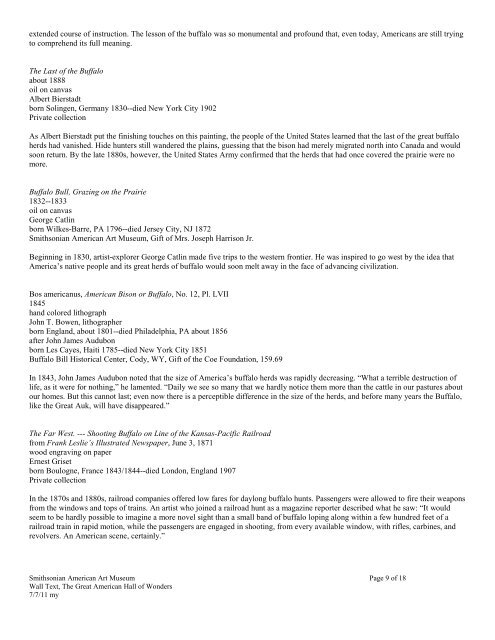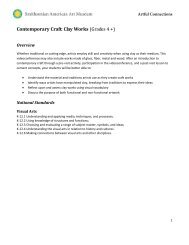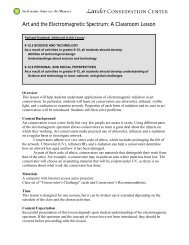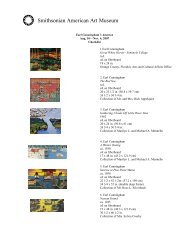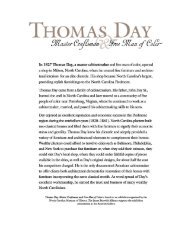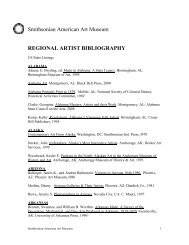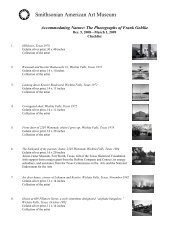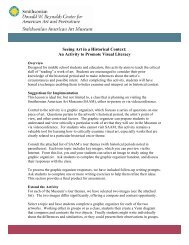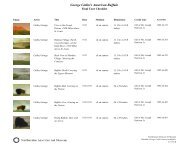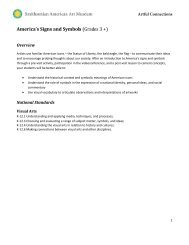Smithsonian American Art Museum - Smithsonian Institution
Smithsonian American Art Museum - Smithsonian Institution
Smithsonian American Art Museum - Smithsonian Institution
You also want an ePaper? Increase the reach of your titles
YUMPU automatically turns print PDFs into web optimized ePapers that Google loves.
extended course of instruction. The lesson of the buffalo was so monumental and profound that, even today, <strong>American</strong>s are still trying<br />
to comprehend its full meaning.<br />
The Last of the Buffalo<br />
about 1888<br />
oil on canvas<br />
Albert Bierstadt<br />
born Solingen, Germany 1830--died New York City 1902<br />
Private collection<br />
As Albert Bierstadt put the finishing touches on this painting, the people of the United States learned that the last of the great buffalo<br />
herds had vanished. Hide hunters still wandered the plains, guessing that the bison had merely migrated north into Canada and would<br />
soon return. By the late 1880s, however, the United States Army confirmed that the herds that had once covered the prairie were no<br />
more.<br />
Buffalo Bull, Grazing on the Prairie<br />
1832--1833<br />
oil on canvas<br />
George Catlin<br />
born Wilkes-Barre, PA 1796--died Jersey City, NJ 1872<br />
<strong>Smithsonian</strong> <strong>American</strong> <strong>Art</strong> <strong>Museum</strong>, Gift of Mrs. Joseph Harrison Jr.<br />
Beginning in 1830, artist-explorer George Catlin made five trips to the western frontier. He was inspired to go west by the idea that<br />
America’s native people and its great herds of buffalo would soon melt away in the face of advancing civilization.<br />
Bos americanus, <strong>American</strong> Bison or Buffalo, No. 12, Pl. LVII<br />
1845<br />
hand colored lithograph<br />
John T. Bowen, lithographer<br />
born England, about 1801--died Philadelphia, PA about 1856<br />
after John James Audubon<br />
born Les Cayes, Haiti 1785--died New York City 1851<br />
Buffalo Bill Historical Center, Cody, WY, Gift of the Coe Foundation, 159.69<br />
In 1843, John James Audubon noted that the size of America’s buffalo herds was rapidly decreasing. “What a terrible destruction of<br />
life, as it were for nothing,” he lamented. “Daily we see so many that we hardly notice them more than the cattle in our pastures about<br />
our homes. But this cannot last; even now there is a perceptible difference in the size of the herds, and before many years the Buffalo,<br />
like the Great Auk, will have disappeared.”<br />
The Far West. --- Shooting Buffalo on Line of the Kansas-Pacific Railroad<br />
from Frank Leslie’s Illustrated Newspaper, June 3, 1871<br />
wood engraving on paper<br />
Ernest Griset<br />
born Boulogne, France 1843/1844--died London, England 1907<br />
Private collection<br />
In the 1870s and 1880s, railroad companies offered low fares for daylong buffalo hunts. Passengers were allowed to fire their weapons<br />
from the windows and tops of trains. An artist who joined a railroad hunt as a magazine reporter described what he saw: “It would<br />
seem to be hardly possible to imagine a more novel sight than a small band of buffalo loping along within a few hundred feet of a<br />
railroad train in rapid motion, while the passengers are engaged in shooting, from every available window, with rifles, carbines, and<br />
revolvers. An <strong>American</strong> scene, certainly.”<br />
<strong>Smithsonian</strong> <strong>American</strong> <strong>Art</strong> <strong>Museum</strong> Page 9 of 18<br />
Wall Text, The Great <strong>American</strong> Hall of Wonders<br />
7/7/11 my


